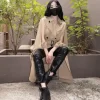Abaya in some other parts of the world, like North Africa, Asia Minor, and the Middle East, is known as an Abayat that is the religious clothing mandatory for Muslim women in some parts of the world. The word Aba means dark black as it denotes the Aba is dark black loose-over garment robe-like dress, which covers the entire body except for hands, feet, face, and head. Over time Abaya is the prestigious symbol of women dressing in the Islamic world. Women wore Abaya or Trendy Abaya clothing on specific religious occasions, celebrations, and festivals like Eid-ul-Fitr and Eid-al-Adha. With time, dressing sense drastically changed in previous years, and rigid Abaya dress transformed into a fashion statement for the women. Moreover, Oman annually hosts various fashion events for Abaya dress designers or Trendy Abaya clothing.
Today in the Islamic world, Muslim women incorporating modern fashion into Islamic clothing. Trendy Abaya clothing gives them an edge when it comes to the fashionable clothes of the modern world. It is a combination of religious devotion and representation of their culture in a dignified manner.
The history behind Abaya clothing
Historical records of Abaya dress clothing dates back to four-thousand-year-old Mesopotamian civilization, previously covering women body with a loose robe-like garment was a style statement, luxury, and status symbol than a representation of religious affiliation. In a post-Islamic era in religious verses covering of body with loose garments and the significance of Abaya increased many folds.
Abaya clothing garment
Abaya clothing garment is a long flowing, loosely fitted garment that covers most of the body, and with long sleeves, only revealing part is the face and is covered by hijab and niqab. Mostly Abaya comes in black color with different shades and multiple round designs on the neck of the dress. Nowadays, Abayas are created by considering religious and local themes with current trends of styles and cuts.
Significance of Abaya dress
In the Arabian Peninsula, the Abaya garment is a fashion statement and promotion of culture. In countries like Qatar, Abaya is predominant in society with luxury and status attached to it. Most Expats in the gulf states wore Abaya to gel with the local populace. In the street of Gulf states, Abaya is common. It is also the norm and fashion statement. Nowadays, the Abaya clothing trend is booming in the countries like Pakistan, India, and Indonesia. In Sub-Saharan countries, the loosely fitted garment is the best choice for women to wear the Abaya and cover their body from prickly heat.
Evolution of Abaya garment throughout last 50 years
A course of the history of the Abaya dress witnessed various designs and variations. In the pre-oil era, Upper-class women used to wear Abaya, previously it was a “laff” with two holes for hand and a gold plated design on the neck, and the head covered by a scarf. In the 70s, when oil was found, back then, Abaya dress adapts few changes and that change was the new silk material. At that period, the Abaya dress garment did not cover the entire body. It was up to the waist. So another part of the body was covered by different clothing.
In the decade of the ’80s, finally, the shoulder Abaya was introduced. A cloak-like garment that covers the whole body was the complete single-piece dress with proper full sleeves and embroidery on the neck part with a new variety of design and silk material was in use. Crepes and chiffons were also in use were flowier on a loose fitted Abaya.
Over time Abaya’s style and shape remain the same with a little bit of modification in the design, like Embroidery work with golden-silver chains and stones were ironed on it. It became the new norm, and then it became a new fashion trend in the late 90s.
In the 2000s, the Abaya dress comes with different shapes, designs, and cuts on the sleeves, on the neck various designs like butterfly and bat designs on the gown on the lower part of the body. Now it truly becomes the expression of self and individualism.
Rising trend of wearing Abayas
Now, Abaya is not just a body covering garment, it transcends into fashionable modern clothing. Designers blend it with a new height of design and styles par with western clothing. In general, Abayas is popular in the Middle East designers took it to a whole new level tweaked it to the current fashion trend.
Renowned brands like Dolce and Gabbana creating stunning new fashionable Abayas are becoming more popular in South Asia and Southeast Asia. The trend of wearing Abayas is increasing in the Muslim world women looking for a trademark dress.
New changes in design and style Abaya contemporary giving a tough job to the western clothing.
Attractive varieties and color
Abaya in the Middle East was in black in the initial days, fortunately now Abayas dresses are multicolor with different styles with leaflet designs on them. Abayas are slips over the chest with various attractive designs crafted on the neck. It is the primary reason Gulf women are well dressed. Fine cutting, excellent fabric, exquisite style, decorations, and light glance painting on Abayas make them different from others.
Making it perfect for women working in the profession
For working women, elegance, style statement, and confidence are vital to climbing the ladder of success in the corporate world. Keeping religious norms and standard dress regulation, the stylish Abaya dress gives them the necessary boost to project themselves grandly without any taboo attached to faith.
Conclusion
The bulk of women who love to wear Abaya is suitable for the hot-humid tropical environment, local dusty weather, and compatible with their religious beliefs. Modern women believe in modest fashion garments, and Abayas allows them to style with elegance. Gone are the days when Abaya were dark black garments with no upfront style on them. Muslim females wearing modest and fashionable Abayas to keep in check with the modern-day lifestyle. Abaya dress garment is a lucrative piece of cloth for modern women.
I believe in the power of words and I think God has blessed me with the same. I have a strong experience in the area of writing and love to share my work with the readers. Happy reading!!







